winter tires AUDI A4 AVANT 2008 Owners Manual
[x] Cancel search | Manufacturer: AUDI, Model Year: 2008, Model line: A4 AVANT, Model: AUDI A4 AVANT 2008Pages: 368, PDF Size: 46.19 MB
Page 38 of 368

Driver inf orma tion di spl ay
The speed warning system warns the driver if he exceeds a previ
ously stored maximum speed . A warning tone wi ll sound as soon as
the vehic le speed exceeds the set speed by about 6 miles per hour
(10 km/h) . At the same time, a warning symbol appears in the
display~ fig. 21 .
The speed warning system has
t wo wa rning thre sholds that func
tion independent ly of each other and that have somewhat different
purposes:
Sp eed w arnin g 1 -
You can use speed warning 1 to set the maximum speed while you
are driving . This setting will remain in effect until you turn off the
ignition, assuming that you have not changed or reset the setting.
The speed warning symbol (USA models)/ (: (Canada models) in
the warning 1 disp lay appears when you exceed the maximum
speed. It goes out when the speed falls be low the stored maximum
speed .
The speed warning symbol will also go out if the speed
exceeds the
stored maximum speed by more than about 25 mph (40 km/h) for at
least 10 seconds. The stored maximum speed is de leted.
Setting speed warning 1
~ page 36 .
S pee d w arni ng 2
Storing warning 2 is recommended if you always want to be
reminded of a certain speed, for example when you are traveling in
a country that has a genera l maximum speed limit, or if you do not
want to exceed a specified speed for winter tires.
The speed warning 2 symbol, (USA models)/ (Canada models) appears in the disp lay when you exceed the stored speed limit .
Unlike warning 1, it wil l not go out until the vehicle speed drops
below the stored speed limit .
Setting speed warning 2
~ page 37.
[ i ] Tip s
Even though your vehicle is equipped with a speed warning system,
you shou ld still watch the speedometer to make sure you are not
driving faster than the speed l imit. •
Speed warning 1: setting a speed limit
Warning thresh old 1 is set by the CHECK button .
Storing the maximum s pee d
- Drive at the desired maximu m speed.
Fig. 22 C HECK button
i n t he in strum ent
c lust er
Briefly press the CHECK button ~ fig. 22 .
Resetting th e ma ximum sp eed
Drive the ve hicle at a speed of at least 3 mph (5 km/h)
Press the CH EC K butto n for at least two seconds .
The speed warning symbo l r I· (Canada models) appears briefly
in the display when you re lease the button to indicate that the
maximum speed has been stored success ful ly . The maximum speed
~
Page 244 of 368

llffll.___l_n _t _e _ll _ig =- e_n _ t_ te_ c_h _n_ o_ lo-'g'"'-=- y ___________________________________________ _
• Be aware of the different than usua l steering response and
adjus t you r steer ing forc e acc ordin gly.
• Have the prob lem checked and set right by an Audi dea ler as
s o on as poss ible.
[ i] Tips
• When t he engi ne is running, never ho ld t he steer ing w heel
turned all the way to the right or to the left for longer than 15
seco nds. Th e powe r steering p ump w ill ove rhea t th e hydra ulic flu id
if you keep holding the steer ing whee l turned a ll the way . T his is
l ike ly to d amage t he powe r stee ring sys tem.
• I f the power steering system should fail entirely, or if the engine
i s not r unning ( for e xa mpl e, while being t owed), you will still be able
to steer the vehicle . However,
considerably more effort wil l be
r e q uired to do s o.
• I f the power steering system should have a lea k, or is not func
t ioning pr operly, co nt ac t yo ur auth orize d Audi deale r immedia tely.
• T he power steering system requires a specia lly formu lated
h ydraulic fluid. T he power s teeri ng reserv oir is th e one loca ted m ost
forward on the left side of the engine
compartment=> page 265,
"Engine co mpartme nt". The c orrect f luid level in the reservoir is
important for proper functioning of the power steering .•
Ap plies to veh icl es : w ith A ll Whee l Dr ive
Driving with your quattro®
Wit h All Whe el Dr ive, all fo ur w heel s are d riven .
Gen eral information
With All W heel Dr ive, powe r is d istributed to all four w hee ls . T hi s
happens automatica lly depending on your dr iving style and the
r oa d c ondit ions at th e time. See
also => page 237, "Elec tronic diff er
entia l lock (E DU" .
Winter tires
When driv ing in th e win te r, yo ur ve hicle with All Wheel Drive ha s an
advantage, even with regular t ires. In winter road conditions it may
b e advi sable to m ount win ter tires ( or all -s easo n tires) for impr oved
driveabi lit y and braking : th ese tires mus t be moun ted on
all four
wheels .
See also => page 31 0, "Winter tires".
Snow chains
Whe re snow cha ins a re ma ndato ry on certai n roa ds, th is norma lly
a lso app lies to veh ic les with a ll-wheel
dr ive=> page 311, "Snow
chain s".
Replacing wheels /tires
Ve hicles wit h All Wheel D rive mu st always have t ires of the sa me
size . A lso avo id tires with different tread depths . For details see
page
=> page 305 .
Off-Road dri ving?
Yo ur Au di d oes not have e nough gr ound clea ra nce to be use d as an
off -road vehic le . It is therefore best to avoid rough tracks and
u neven te rr ain as much as poss ible . Also refe r
to => page 2 45.
& WARNING
Alway s adjust your driving to road and traffic condition s. Do not
let the extra safety afforded by the all -wheel drive tempt you into
taking extra risks .
• Although the quattro ®all-wheel drive is very effective, always
remember that braking capacity is limited by tire traction. You
should therefore not drive at e xcessive speeds on icy or slippery
road surfaces.
• On wet road surfaces , be careful not to drive too fast be cause
the front wheels could begin to slide on top of the water (hydro
planing ). If this should occur , you will have no warning from a
sudden increase in engine speed as with a front -wheel drive
vehicle . Always drive at speeds which are adjusted to the road
conditions - risk of crash! •
Page 258 of 368
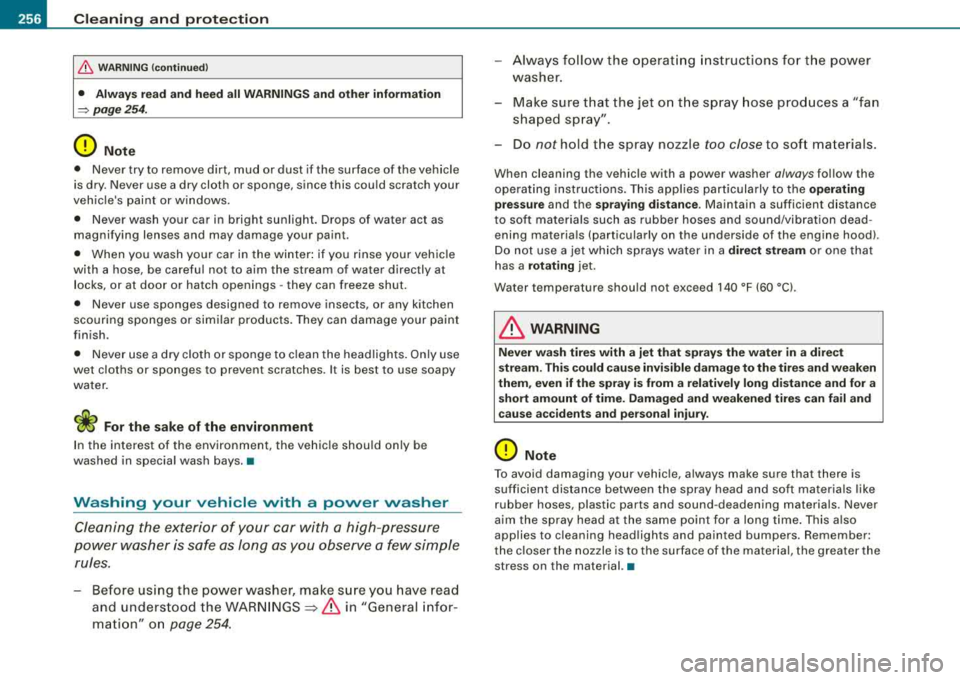
___ C_ le_a_ n_in ~ g_ a_n _ d_ p_ ro_ t_e _c _t _io _ n ___________________________________________ _
&, WARNING (continued )
• Always read and heed all WARNINGS and other information
=> page 254 .
0 Note
• Never try to remove dirt, mud or dust if the surface of t he veh icle
is dry. Never use a dry cloth or sponge, since this cou ld scratch your
veh ic le's paint or w indows .
• N ever wash your car in bright sunlight . Drops of water act as
magnifying lenses and may damage your paint.
• When yo u wash your ca r in the winter : if you rinse you r ve hicle
with a hose, be carefu l not to aim the stream of water directly at
l ocks, or at door or hatch openings -they can freeze shut.
• Never use sponges designed to remove insects, or any kitchen
scouring spo nges or similar pr oducts. They can damage yo ur paint
finish .
• Never use a dry cloth or spo nge t o clean the head ligh ts . O nly use
wet cloths or sponges to prevent scratches . It is best to use soapy
water.
<£> For the sake of the environment
I n the interest of the environment, the vehic le shou ld on ly be
washed in specia l wash bays. •
Washing your vehicle with a power washer
Cleaning the exterior of your car w ith a high -p ressure
po wer w asher is s afe as l ong as you observe a few simple
rules .
-Before us ing the power washer, make s ure you have rea d
and unders tood the
WAR NINGS:=> & in "General infor
mati on" o n
page 254.
-Always follow the operating instru ctio ns fo r th e p owe r
w ash er.
-Make sure t hat t he jet o n the spray hose pro duces a "fan
sha ped sp ray".
-Do not hold the spray nozzle too close to soft ma terials.
When cleaning the vehicle w ith a power washer always follow the
opera tin g instruc tions. Th is appl ies partic ula rly to the
operating
pre ssure
and t he spraying distance . Maintain a sufficient distance
t o so ft m ateria ls such as rubber hoses and sound/vib rat ion dead
ening materia ls (particularly on the underside of the engine hood).
D o no t use a jet w hich sprays wa ter in a
direct stream o r one tha t
has a
rotating j et .
Water temperature shou ld not exceed 140 °F (60
°CJ.
& WARNING
Never wash tires with a jet that sprays the water in a direct
s tream . This could cause invi sible damage to the tire s and weaken
them , even if the spray is from a relatively long distan ce and for a
s hort amount of time . Damaged and weakened tires c an f ail and
ca use ac cidents and personal injur y.
0 Note
To avoid damaging your vehic le, always make sure that there is
su fficient dis tance between the spray head and so ft m ater ia ls l ike
rubber hoses , plastic parts and sound -deadening materials . Never
a im the spray head a t the same p oint for a l ong time . This a lso
applies to cleaning head lights and painted bumpers . Remember:
t he c loser t he n ozzle is to the surface o f the mate rial, the greater the
stress on the material. •
Page 298 of 368
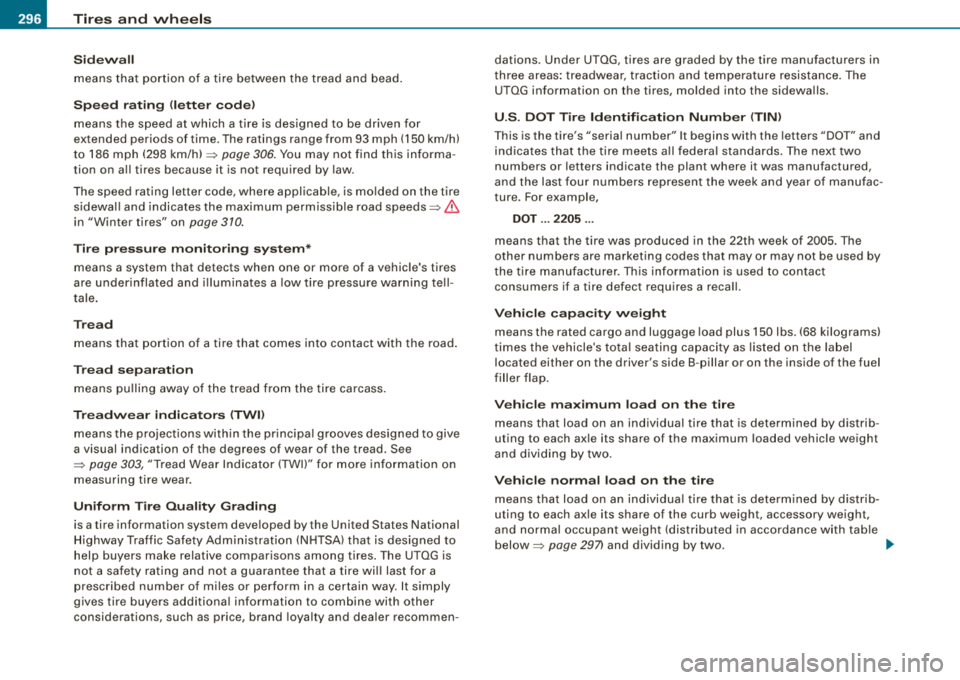
___ T_ ir_e _ s_ a_ n
_ d_ w_ h_ e_ e_ls _________________________________________________ _
S idewa ll
means t hat port ion of a tire between the tread and bead.
Speed ra ting
extended periods of time. The ratings range from 93 mph (150 km/h)
to 186 mph (298
km/h) => page 306. You may not f ind this informa
tion on a ll tires because it is not required by law .
The speed rating letter code, whe re applicable, is mo lded on the tire
s idewal l and indicates the maximum perm issible road
speeds => &
in "Winter tires" on page 310.
Tire pr essu re m onitorin g sys tem *
means a system that detects when one or more of a vehicle's tires
are under inflated and i lluminates a low tire pressure warning te ll
tale .
Tread
means that portion of a tire that comes into contact with the road.
Trea d sepa ration
mea ns pu lling away of the tread from the tire carcass.
Tr eadw ear indi cato rs ( TWI)
mea ns the projections with in the pr incipa l grooves designed to give
a visual indication of the degrees of wear of the tread . See
=> page 303, "T read Wear Indicator (TWI)" for m ore information on
measuring tire wear.
Uniform Tire Qualit y Grading
is a tire information system deve loped by the United States National
H ighway Traff ic Safety Admin istration (N HTSA) t hat is designed to
help buyers make relative comparisons among tires. The U TQG is
n ot a safety rating and not a guarantee that a tire will last for a
prescribed number of miles or perform in a certain way . It simply
gives ti re buyers additiona l info rmation to combine with other
considerations, such as price, brand loyalty and dea ler recommen -dations
. Under UTQG, tires are graded by the tire manufacturers in
t hree areas : treadwear, tract ion and tempera ture resista nce. The
U TQG information on the tires, molded into the sidewa lls .
U .S . D OT Tire Identification Number (TIN )
This is the tire's "seria l number" It begins with the letters "DOT" and
indicates that the tire meets a ll federa l standards. The next two
numbers or letters indicate the plant where it was manufactured,
and t he last four numbers represent the wee k and year of manufac
ture. For example,
DOT ... 2205 ...
means t hat the tire was produced in the 22t h week of 2005. The
other numbers are marketing codes that may or may not be used by
t he t ire manufacturer. This informat ion is used to c ontac t
consumers if a tire defect requires a reca ll.
Veh icle capacity we ight
means the rated cargo and luggage load plus 150 lbs . (68 kilograms)
t imes t he vehicle's total seating capaci ty as listed on the la bel
located either on the driver's side 8 -pillar or on the inside of the fuel
fi ller flap .
Vehi cle max imum l oad on th e tir e
means that load on an ind ividual tire that is determ ined by distrib
uting to each axle its share of the maximum loaded vehicle weight
and d ividing by two.
V ehi cle norm al l oa d on th e tir e
means that load on an ind ividual tire that is determ ined by d istrib
uting to each axle its share of the curb weight, accessory weight,
and normal occupant weigh t (distributed in accorda nce w ith tab le
below=> page 297) and dividing by two . _.,
Page 310 of 368
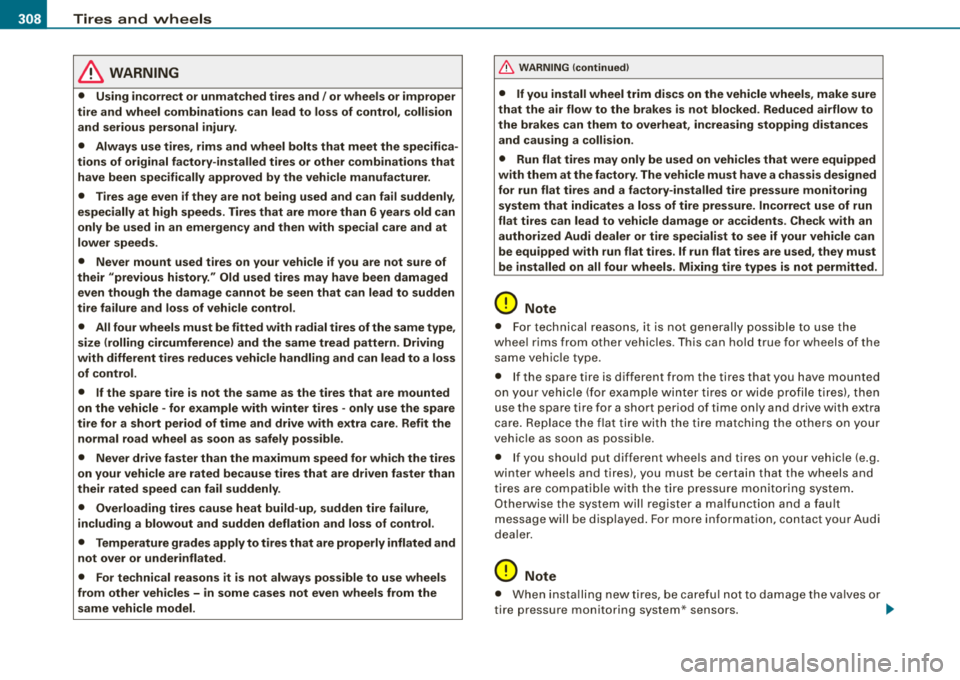
___ T_ ir_e _ s_ a_ n
_ d_ w_ h_ e_ e_ls _________________________________________________ _
& WARNING
• Using incorrect or unmatched tires and / or wheels or improper
tire and wheel combinations can lead to loss of control , collision
and serious personal injury .
• Always u se tires , rims and wheel bolts that meet the specifica
tions of original factory -installed tires or other combinations that
have been specifically approved by the vehicle manufacturer.
• Tires age even if they are not being used and can fail suddenly ,
especially at high speeds . Tires that are more than 6 years old can
only be used in an emergen cy and then with special care and at
lower speed s.
• Never mount used tires on your vehi cle if you are not sure of
their "previous history." Old used tires may have been damaged
even though the damage cannot be seen that can lead to sudden
tire failure and loss of vehicle control.
• All four wheels must be fitted with radial tires of the same type ,
size (rolling circumference ) and the same tread pattern. Driving
with different tires reduces vehi cle handling and can lead to a loss
of control.
• If the spare t ire is not the same as the tires that are mounted
on the vehicle -for example with winter tires -only use the spare
tire for a short period of time and drive with extra care . Refit the
normal road wheel as soon as safely possible.
• Never drive faster than the ma ximum speed for wh ich the tires
on your vehicle are rated because tires that are driven faster than
their rated speed can fail suddenly .
• Overloading tire s cause heat build -up , sudden tire failure ,
including a blowout and sudden deflation and loss of control.
• Temperature grades apply to tires that are properly inflated and
not over or underinflated .
• For technical reasons it is not always possible to use wheel s
from other vehicles - in some cases not even wheels from the
same vehicle model.
& WARNING (continued )
• If you install wheel trim discs on the vehicle wheels, make sure
that the air flow to the brakes is not blocked . Reduced airflow to
the brakes can them to overheat , increasing stopping distances
and causing a collision .
• Run flat tires may only be used on vehicles that were equipped
with them at the factory. The vehicle must have a chassis designed
for run flat tires and a factory-installed tire pressure monitoring
s ystem that indicate s a loss of tire pressure . Incorrect use of run
flat tires can lead to vehicle damage or ac cidents . Check with an
authorized Audi dealer or tire specialist to see if your vehicle can
be equ ipped with run flat tires . If run flat tires are used , they must
be installed on all four wheels . Mixing tire types is not permitted.
0 Note
• For tec hnical r eas ons, it is no t gene rally possible to use the
whee l rims from other vehicles . ihis can hold true for wheels of the
same ve hicle type.
• I f the spare tire is different from the tires that you have mounted
on y our ve hicle (f or exampl e wi nter t ires or wide p ro fi le tir es), then
use the spa re tire fo r a short per iod of time on ly and d rive with extra
c a re . Rep lace the flat t ire wi th the ti re m atc h ing t he oth ers o n you r
vehic le as soon as possib le .
• If yo u should put diff eren t w heels a nd tires on yo ur vehi cle (e. g.
winter wheels and tires), you must be certa in that the wheels and
t ires a re co mpatibl e w ith the tire press ur e m onit orin g sys te m.
Otherwise the system will regist er a ma lfunction and a fau lt
mes sage wil l be d isp layed . Fo r mo re info rmation, contact yo ur Audi
dea ler .
0 Note
• When i nsta lling new ti res, be care fu l n ot to damage t he va lves o r
tire press ure mon itoring system* sensors . .,_
Page 312 of 368
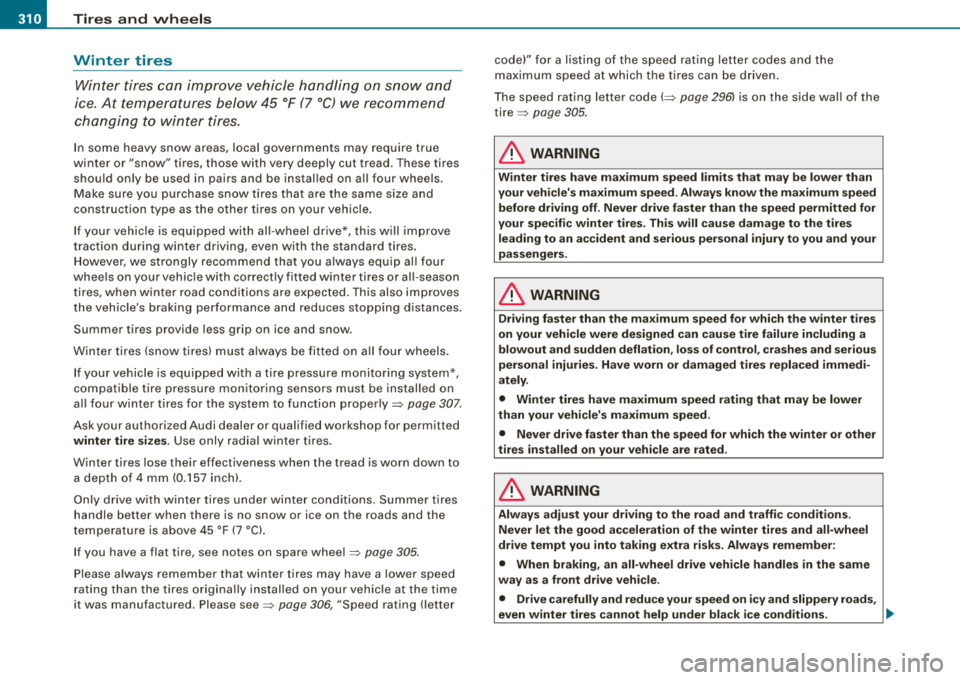
___ T_ ir_e_ s_ a_ n
_ d_ w_ h_ e_ e_l_
s _________________________________________________ _
Winter tires
Winter tires can impr ove vehicle handling on snow and
ice. At temperatures below 45 °F (7 °C) we recommend
changing to winter tires.
I n some heavy snow areas, local governments may require true
winter or "snow" tires, those with very deeply cut tread . These tires
should only be used in pairs and be instal led on a ll four wheels .
Make sure you purchase snow tires that are the same s ize and
construction type as the other tires on your vehicle .
If your vehic le is equipped with al l-wheel drive*, this will improve
traction during winter driving, even with the standard tires.
H owever, we strongly recommend that you a lways equ ip al l four
whee ls on your vehic le with correct ly fitted winter tires or all-season
t ires, when winter road conditions are expec ted. This also improves
t he vehic le's braking performance and reduces stopping distances.
Summer tires provide less grip on ice and snow.
W inter tires (snow t ires) must a lways be fi tted on a ll four wheels .
If your vehicle is equipped with a tire pressure monitoring system* ,
compatible tire pressu re monitoring sensors must be instal led on
a ll f our winter t ires for the system to function
properly=> page 307.
Ask your authorized Audi dealer or qualified workshop for permitted
winter tire size s. Use only rad ial winter tires.
Winter tires lose their effect iveness when the tread is worn down to
a depth of 4 mm (0.157 inch).
Only drive with w inter tires under winter conditions. Summer tires
handle better when there is no snow or ice on the roads and the
t emperature is above 45 °F (7 °C).
If you have a flat tire, see notes on spare
wheel=> page 305 .
Please a lways remember that winter tires may have a lower speed
rating than the tires original ly instal led on your vehicle at the ti me
it was manufactured . Please see
=> page 306 , "Speed rating (letter code)" for a listing of the speed rating letter codes and the
maximum speed at which t he tires can be d riven .
The speed rating letter
code(=> page 2961 i s on the side wa ll of the
tire => page 305.
& WARNING
Winter tire s have maximum speed limits that may be lower than
your vehi cle's ma ximum speed . Al wa ys know the ma ximum speed
before driving off . Never drive fa ster th an the speed permitted for
y our s pecifi c w inter tire s. Thi s will cau se damage to the tire s
lead ing to an a ccident and seriou s per sonal injury to you and your
p ass engers.
& WARNING
Driving fa ster th an the m aximum speed for whi ch the winte r tire s
on your vehi cle were de signed c an cause tir e failure in cluding a
blowout and sudden deflat ion , lo ss of contr ol, c rashe s and seriou s
per sonal injuries . Have worn or damaged tires repl aced immedi
ately .
• Winter tires have ma ximum speed rating that may be lower
than your vehicle' s m axi mum speed .
• Never drive faster than the speed for which the winter or other
ti re s in sta lled on you r vehi cle are r ated .
& WARNING
Always adju st your driving to the ro ad and traff ic condit ions .
Never let the good acceleration of th e win ter tire s and all-wheel
dr ive tempt you into taking extra ri sks. Al ways rem ember :
• When braking, an all -wheel driv e vehicle handle s in th e same
w ay as a front dr ive veh icle .
• Drive ca refully and redu ce your speed on i cy and slippery r oads,
e ven w inter tires cannot h elp under bl ack ice condit ions .
...,
Page 314 of 368
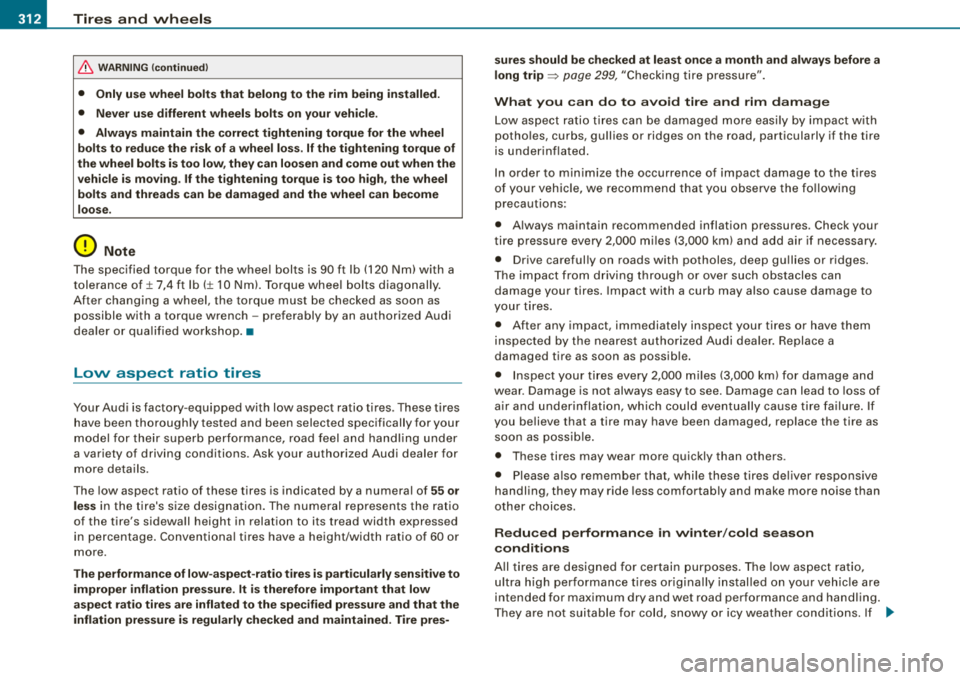
-
Tires and wheels
----------------
&, WARNING (continued )
• Only u se wheel bolts that belong to the rim being installed.
• Never use different wheels bolt s on your vehi cle .
• Alway s maintain the correct tightening torque for the wheel
bolts to reduce the risk of a wheel los s.
If the tightening torque of
the wheel bolts is too low , they can loosen and come out when the
vehi cle is moving. If the tightening torque is too high , the wheel
bolts and threads can be damaged and the wheel can become
loose .
0 Note
The specified torque for the wheel bolts is 90 ft lb (12 0 Nm) with a
tolerance of± 7,4 ft lb(± 10 Nm). Torque whee l bolts diagonally.
After changing a wheel, the torque must be c hecked as soon as
possible with a torque wrench -preferably by an authorized Audi
d ea ler or qua lifi ed works hop.•
Low aspect ratio tires
Your Aud i is factory -equipped with low aspect ratio tires . T hese tires
have been thorough ly tested and been selected specifical ly for your
mod el for t he ir superb perf or mance, r oad feel and ha ndling u nder
a variety of driving conditions . Ask your authorized Audi dealer for
mo re deta ils.
The low aspect ratio of these tires is indicated by a numeral of
55 or
less
i n the ti re's size designatio n. The numeral rep resents the ra tio
of the t ire's sidewa ll height in relation to its tread width expressed
in percentage . Conventiona l tires have a height/width ratio of 60 or
m ore.
The performan ce of low -aspe ct-ratio tires is part icularly sensitive to
improper inflation pressure . It is therefore important that low
aspe ct ratio tires are inflated to the specified pressure and that the
inflation pressure i s regularly checked and maintained. Tire pres- sures should be checked at least once a month and always before a
long
trip => page 299, "C heck ing tire pre ssure" .
What you can do to avoid tire and rim damage
Low as pect r ati o ti res can be da maged more easi ly by impact w ith
potho les, curbs, gullies or ridges on the road, particularly if the tire
i s u nde rinfl ated.
I n order to min imize the occurrence of impact damage to the t ires
of your vehic le, we recommend that you observe the fo llowing
precautions :
• Always maintain recommended inflation pressures . Check your
t ire pr essu re every 2,000 miles (3,000 k m) a nd add air if necessary .
• Drive careful ly on roads with potholes, deep gu llies or ridges.
T he im pac t from driving t hroug h or ov er suc h ob stacl es ca n
damage your tires. Impact with a curb may also cause damage to
yo ur tir es .
• After any impact, immediately inspect your tires or have them
inspec te d by the neares t au thori ze d Aud i dealer. Replac e a
damaged tire as soon as possible.
• I nspect you r ti res eve ry 2,0 00 m iles (3,000 km) for damage and
wear. Damage is not always easy to see. Damage can lead to loss of
a ir a nd und eri nfl ation, whic h cou ld eve ntual ly ca use tire fa ilur e. If
you be lieve that a tire may have been damaged, rep lace the tire as
s o on as p ossi ble.
• T hese tires may wear more quickly than others .
• P lease a lso remember that, whi le these tires de liver respons iv e
handling, they may ride less comfortably and make more noise t han
other choices.
Reduced performance in winter /cold season
c onditions
A ll tir es a re desig ned f or certai n purposes. The low a spect rati o,
u ltra hi gh pe rf ormance t ires or igin a lly ins tal led on your ve hicle are
intended for maximum dry and wet road performance and handling .
Th ey a re not su itab le fo r co ld, snowy or ic y weat her co nd it io ns. If
~
Page 315 of 368
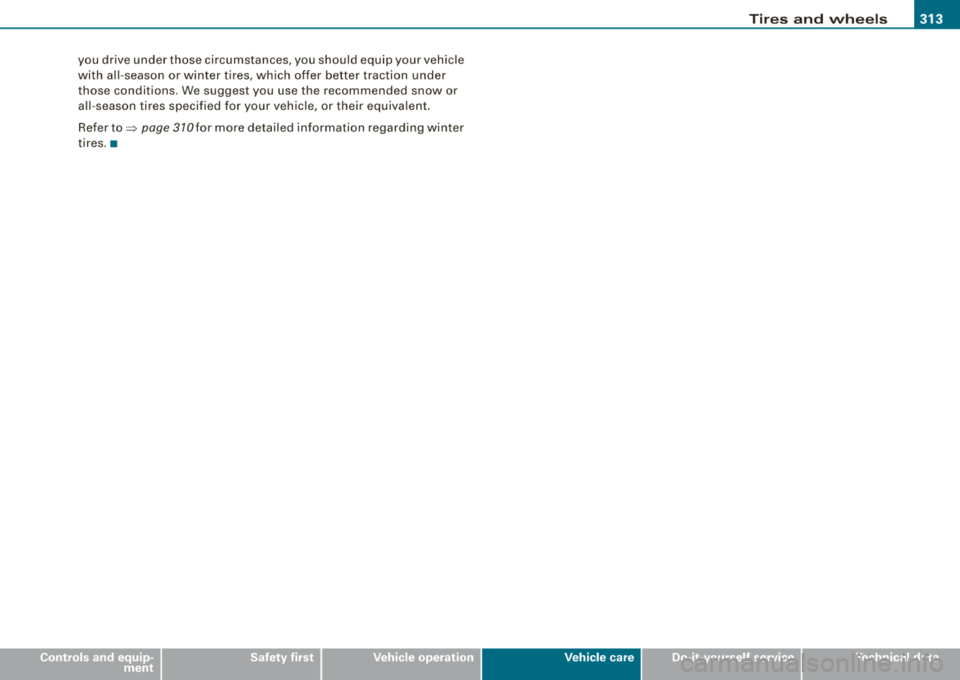
Tires and wh eels -
----------------
you drive under those circumstances, you should equip your vehicle
with al l- season or win ter t ires, wh ich offer be tter traction under
those conditions . We suggest you use the recommended snow or
a ll-season tires specified for your vehicle, or their equivalent .
Refer
to => page 310for more detai led information regarding winter
tires. •
Vehicle care
Page 355 of 368
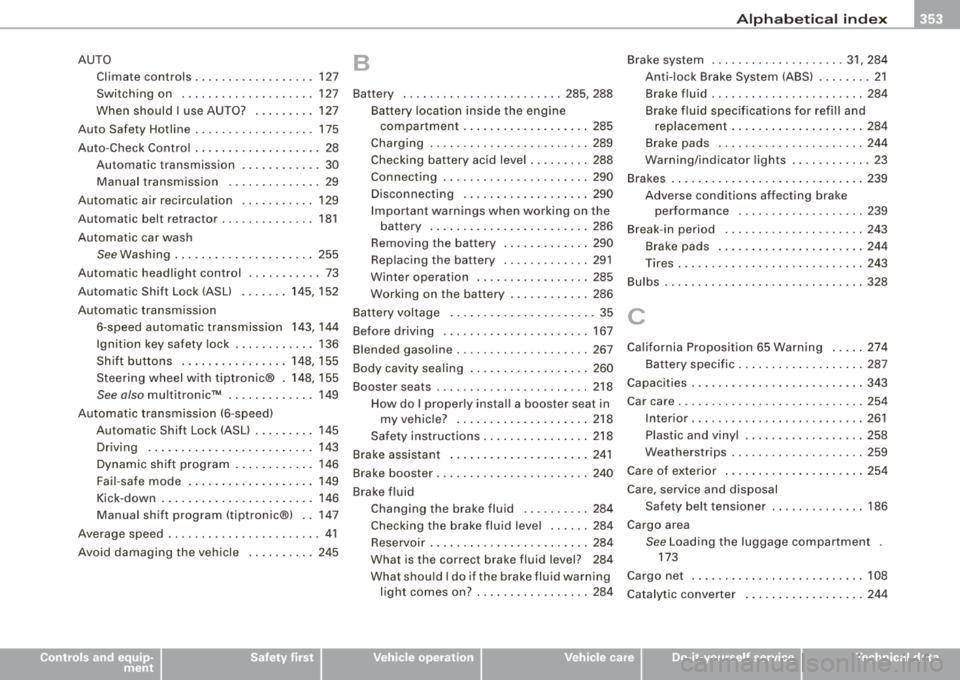
Alph ab eti ca l ind ex -
-------------=----
AUTO
Climate controls ...... .... ...... .. 127
Switching on .................... 127
When should I use AUTO? ......... 127
Auto Safety Hotline ................. . 175
Auto-C heck Contro l ...... .... ... .... .. 28
Au toma tic transmission ...... .... .. 30
Manua l transmission .. ...... .... .. 29
Automa tic a ir recircu lation ........... 129
Automatic belt retractor .......... .... 181
Automat ic car was h
See Washing ...... .... ... .... .... 255
Automatic headlight control ........... 73
Automatic Sh ift Lock (ASU .. ..... 145, 152
Automatic transmission 6-speed automatic transmission 143, 144
Ign it ion key safety lock . ...... .... . 136
Shift but tons .. ...... .... .... 148, 155
Steering wheel wit h tiptronic® . 148,155
See also mu ltit ronic™ ... .. ...... .. 149
Automat ic trans mission (6 -speed)
Automat ic Shift Lock (ASU ... .. ... . 145
Driving .. .. .. .... .... ..... .. .... 1 43
Dynamic shift program ... .... .... . 146
Fa il- safe mode . ...... .... .... .... 149
Kic k-down ... .... .... .... ... .... . 146
Manual shift program (tiptronic®) .. 147
Average speed ....................... 41
Avoid damaging the vehicle .. ...... .. 245
Controls and equip
ment Safety first
B
Battery .....
.... .... .... .... ... 285, 288
Battery location ins ide the eng ine
compartment .. ...... .... .... ... 285
Charging . ............ ........... 289
Checking battery acid level . ........ 288
Connecting .... .. ..... .... .... ... 290
Disconnecting ............ .... ... 290
Important warnings when working on the
battery ... .. .... .... .... .... ... 286
Removing the battery ... .. .... .... 290
Replacing the battery ............. 29 1
Winter operation . ................ 285
Working on the battery ............ 286
Bat tery vo ltage .. ... ... .... .... .... .. 35
Before driving ...................... 167
Blended gasoline . .... ............... 267
Body cavity sealing ...... .... .... ... . 260
Booster seats .......... .... .... ..... 218
How do I properly instal l a booster seat in
my vehicle? ... .. .... .... .... ... 218
Safety inst ructions ... .. .... .... ... 218
Brake assista nt ..... .... .... .... .... 241
Brake booster .......... ...... .... ... 240
Brake f luid
Changing the brake flu id ...... .... 284
Check ing the brake fluid leve l ...... 284
Reservoi r .... .... .... ..... .. .... . 28 4
What is the correct brake f luid level? 284
What shou ld I do if
t he brake fluid warning
l igh t comes on? ... .. .... .... .... 284 Brake system
...... .... .... .... .. 31,284
Anti -lock Brake System (ABS) ........ 21
Brake fluid ....................... 284
Brake f lu id spec ificat ions for refi ll and
replacement ..... .... .... .... ... 28 4
Brake pads ...................... 244
Warning/indicator lights ...... ...... 23
Brakes ...... .... .... .... ... .... .... 239
Adverse cond itions affec ting bra ke
performance ...... .... .... ..... 239
Break -in period ....... ........ ...... 243
Brake pads ........... .... .... ... 244
Tires .. .... ....... .... ...... ..... 243
Bu lbs .. ...... .... .... ... .... .... ... 328
C
Ca lif o rnia Pr opo sit ion 65 War ning ... .. 274
Batte ry specific . ...... .... .... .... 287
Capacities .......................... 343
Car care . .... .... ........... .... .... 254
Interior .... ... .... .... .... .... ... 261
Plastic and vinyl .... ............. . 258
Weatherstrips .... ... .. ...... .... . 259
Ca re of exterior ..... .... .... .... .... 254
Care, service and disposal Safety belt tensioner .............. 186
Cargo area
See Loading the luggage compartment .
173
Cargo net .......................... 108
Catalytic converter ...... .... .... .... 24 4
Vehicle operation Vehicle care Do-it-yourself service Technical data
Page 365 of 368

Alph ab eti ca l ind ex 11111
----------------------------------------- -'------------J
Tire specifications .... ...... .... .. 306
Tread depth .. .... .... ........... 303
Uniform tire quality grading .. .... . 309
Winter tires .. .. .. .... .... ...... .. 310
Tires and vehicle load limits .. ... .... . 301
Tires and wheels Checking tire pressure ... .. ...... . 299
Co ld ti re inflati on pressure ... .. .... 297
Dimens ions ...... .... ... .... .... 305
Genera l notes ..... .... ... .... .... 293
G lossary of tire and loading terminology
294
New tires and whee ls ... .. ..... .. . 305
Replaci ng . ...... .... .... ... .... . 306
Snow chains ... .. .... .... .... .... 311
Tire pressu re monito ring system .. . 307
Tires and vehicle load limits .. ...... 301
Wheel bo lts .. .... .... ... .... .... 311
Winter tires .. .. .. .... .... ...... .. 310
Tires/Wheels Lowaspectrat iotires ..... ... .... . 312
Tire pressure monitoring sys tem . ... 20
T orn or frayed safety belts . ... .... .... 180
Touch -up paint .. .... .... ... .... .... 258
Towing Tow truck procedures
Tow line eye 332
front ...... ... .. .... .... .... .... 333
Trailer towing ... .... .... .... .... ... 248
Operating instructions .... ...... .. 249
Technical requirements ... .... 248, 249
Trailer towing tips ..... .. ...... ... 250
Controls and equip
ment Safety first
Transmission
Vehicle identification ...... .... .... .. 340
6 -speed ... ...... ... .. .... .... ... 142
Vehic le identificati on label . ....... ... . 340
Manual transmission .............. 142
Vehic le Identification Number (V IN) ... . 340
tiptron ic® .......... ...... .... ... 143
Vehicle jack .. .... .... .......... 316, 32 1
Transport Canada ... .... .... .... .... 345
Vehicle l iterature ...... ... .... .... .... . 5
Tread Wear Ind icator (TWll . ....... .. . 303
Vehicle-care products .... .... .... .... 254
Trip computer
Complete -trip memory ............ . 38
Fuel consumption rate ...... .. .... . 38
w
Mi leage .. .... .... .... .... .... ... . 38
Warning lights ... .... .... ...... ... 12, 19
Si ngle -trip memory . ...... .... .... . 38
Warning/i ndicator lights
Trip odometer ... ...... .... ... .. .... . 15
Airbag system .... .... .... ..... .. . 20
dEF indication in the trip odometer
Anti-lock Brake System (ABS) ... .... . 21
display ... .. .... .... .... ... .... . 15
Brake system ..................... 23
Turn s ignals ......................... 80
Cruise control ... .. .... ...... ...... 21
Warning/ind ica tor lights ............ 22
Electronic immobilizer ...... .. ..... 16
Electronic power control ... .... ..... 23
u Electron ic stabil ization program (ESP) 22
Generator ........................ 22
Undercoating ....... ... .. .... .... ... 261
High beam . ....... ... .... .... .... 23
Unfastening safety belts . .... .... .... 18 4
Malfunction Indicator La mp (M IU .... 20
Un idirectiona l tires . .... .... ...... ... 293 Park ing brake .. ...... .... .... ... .. 23
Uniform tire quality grading .. ... .... . 309 Safety belt ..
...... .... .... .... .... 22
U nlocking Tire pressure monitoring system ...
.. 20
Power locking switch ... .. .... .... . 59 Turn signals
...... .... .... .... .... 22
Rear lid ...... .... .... .... ... .... . 61 Warranty coverages .
.... .... .... .... 345
Remote control ................... 56 Washer reservoir .. .... ... .... .... ... 291
Using the key . ............ .... .... 58
Washing .. ...... .... .... ... .... .... 254
Automatic car wash . ...... .... ... . 255
V by hand ...... .... .... ... .... .... 255
with a power washer ... ... .... .... 256
Vanity mirror .... ............. ...... . 84
Washing the vehicle .. .... .... .... ... 254
Veh ic le e lec trical system ... .. .... .... . 22
Washing the vehicle by hand .......... 255
Vehicle operation Vehicle care Do-it-yourself service Technical data